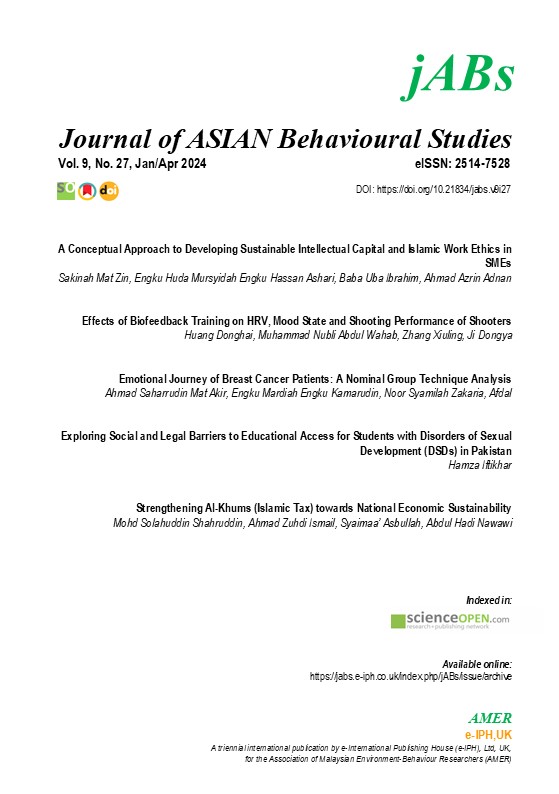Exploring Social and Legal Barriers to Educational Access for Students with Disorders of Sexual Development (DSDs) in Pakistan
Main Article Content
Abstract
Students in Pakistan with Disorders of Sexual Development (DSDs) face significant legal and social barriers to education. Cultural misunderstandings, economic hardship, and inadequate medical care exacerbate these issues. This paper uses a systematic literature review (SLR) to examine existing research on social and legal constraints affecting educational access for children with DSDs in Pakistan. Key findings highlight critical barriers: cultural misunderstandings, lack of community and family support, and insufficient legal recognition. These findings underscore the need for legislative reform, more inclusive policies, and community engagement to improve access to education for these students.
Article Details
License
Copyright (c) 2024 Hamza Iftikhar

This work is licensed under a Creative Commons Attribution-NonCommercial-NoDerivatives 4.0 International License.
References
Ahmed, S., & Ali, N. (2020). Legal frameworks for protecting the rights of individuals with DSDs: A comparative analysis. Journal of Human Rights, 18(4), 567–589. https://doi.org/10.1080/14754835.2020.1843871
Ammermüller, A. (2005). Educational opportunities and the role of institutions. Retrieved from https://papers.ssrn.com/sol3/papers.cfm?abstract_id=753366
Amy, R., Rafael, E., Courtney, M., Maria, F., Sorahia, B., & XY. (2019). Endocrine Reviews, 40(6). https://academic.oup.com/edrv/article-abstract/40/6/1547/5540927
Anca, S., social, C., & educational. (2018). Journal of Career Assessment, 26(3). https://journals.sagepub.com/doi/abs/10.1177/1069072716679924
Baloch, Q., & Khan, M. (2021). Policy challenges and solutions for inclusive education in Pakistan. International Journal of Educational Development, 47, 12-22. https://doi.org/10.1016/j.ijedudev.2021.102013
Bogenschneider, K. (n.d.). Family policy matters: How policymaking affects families and what professionals can do. Retrieved from
Cools, M. (2018). Nature Reviews Endocrinology, 14(1). https://www.nature.com/articles/s41574-018-0010-8
Cowie, H. (2009). Promoting emotional education: Engaging children and young people with social, emotional, and behavioural difficulties. Innovative learning for all. Retrieved from https://books.google.com/books?hl=en&lr=&id=IycQBQAAQBAJ&oi=fnd&pg=PA85&dq=Community+and+Peer+Relationships:%0APeer+bullying+and+social+exclusion.&ots=8oYe7YFyAY&sig=iOlGZzav98EbPEBfJF_1v8exVqg
Emily, K. (2011). Global environmental change, 21(1). https://www.sciencedirect.com/science/article/pii/S0959378011000860
Erica, L., Karen, D., & vol. (n.d.). 5 p. https://www.sciencedirect.com/science/article/pii/S1055858619300988
Garry, J., & Jamal, M. (2008). Disorders of sex development: Their presentation and management in different cultures. Retrieved from https://link.springer.com/article/10.1007/s11154-008-9084-2
Hadfield, G. (2007). Rev. Retrieved from https://heinonline.org/hol-cgi-bin/get_pdf.cgi?handle=hein.journals/stflr60§ion=55
Hoeken, H. (2001). Anecdotal, statistical, and causal evidence: Their perceived and actual persuasiveness. Retrieved from https://link.springer.com/article/10.1023/A:1012075630523
Hornikx, J. (2007). Is anecdotal evidence more persuasive than statistical evidence? A comment on classic cognitive psychological studies. Retrieved from https://repository.ubn.ru.nl/bitstream/handle/2066/44329/44329.pdf?sequence=1
Indyk, J. (2017). Translational Pediatrics, 6(1). https://www.ncbi.nlm.nih.gov/pmc/articles/PMC5682373/
Javed, F., & Ayesha, M. (2019). Social stigma and its impact on the education of children with disabilities in Pakistan. Disability & Society, 34(5), 709–726. https://doi.org/10.1080/09687599.2018.1535621
Jan, K. (2013). Electronic journal of knowledge management, 11(3). Retrieved from https://academic-publishing.org/index.php/ejkm/article/view/972
Khan, R., & Butt, S. (2018). The role of family and community in supporting students with special needs in Pakistan. Journal of Inclusive Education, 25(3), 211–225. https://doi.org/10.1080/13603116.2017.1376639
Kim, K., & S., H. (2016). Prepared for the Office of Disability, Aging, and Long-Term Care Policy, Office of the Assistant Secretary for Planning and Evaluation, US Department of Health and Human Service. Retrieved from https://aspe.hhs.gov/reports/evaluation-aoas-program-prevent-elder-abuse-final-report-0
Ong, A. (2008). Wash. Retrieved from https://heinonline.org/hol-cgi-bin/get_pdf.cgi?handle=hein.journals/wajlp28§ion=11
Rahman, A., & Qadir, F. (2022). Addressing educational inequities for children with DSDs: A case study from rural Pakistan. Educational Research and Reviews, 17(2), 98-110. https://doi.org/10.5897/ERR2022.4072
RT, J. (2017). The Family Journal, 25(3). Retrieved from https://journals.sagepub.com/doi/abs/10.1177/1066480716679651
Scot, J. (1990). American Journal of Sociology, 96(3). Retrieved from https://www.journals.uchicago.edu/doi/abs/10.1086/229572
Siti, H. (2023). Journal of Science, Technology and Innovation Policy, 9(1). Retrieved from https://jostip.utm.my/index.php/jostip/article/view/127
Team, P. (n.d.). Pakistan Landscape Analysis Inception Report. UNICEF. Retrieved from https://docs.edtechhub.org/lib/HL6BNMQZ
Thomas, K., & Corbett, T. (n.d.). In K. Bogenschneider, & T. Corbett, Approach to Policymakers. Retrieved from https://www.taylorfrancis.com/chapters/edit/10.4324/9781003311577-18/approach-policymakers-karen-bogenschneider-thomas-corbett
